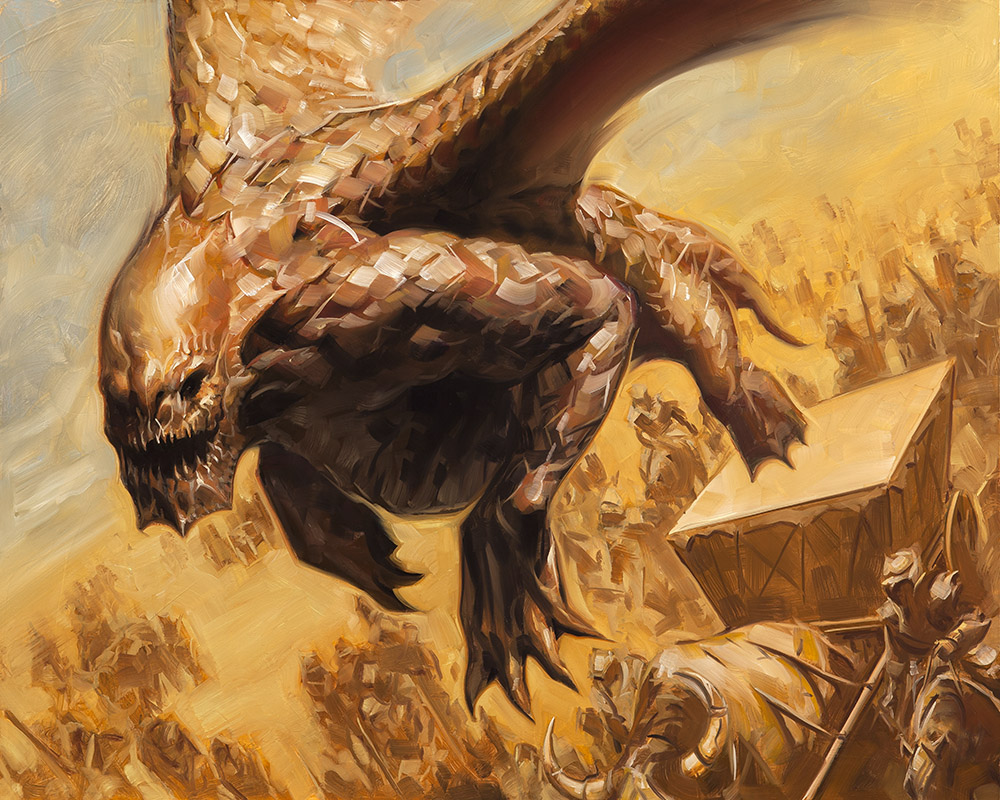David Palumbo
I think we can all agree that revisions are no fun, but it is a part of the job to take them in stride and continue giving our best effort. Even with good communication and sketch feedback, all parties involved in a commission should anticipate fine tuning. That isn’t really much of a problem when the notes are along the lines of “Make the robot a bit more beat up” or “The pistol should be a revolver, not an automatic” or even “The costuming is a bit plain, give it more drama.” Even when the feedback feels nitpicky, at least comments like these are pretty straight forward.
The problematic feedback is the stuff that indicates unhappiness with no clear source or solution. Every now and then I think everyone is or has been faced with that situation. Further discussion sometimes brings more light to what needs fixing, but this type feddback can be demoralizing. Demoralizing in a way that, for me at least, makes asking for clarifications almost the same as just saying “by the way, I have no idea what I‘m doing.”
Not that clarification is likely to help much anyhow. Vague revisions most often happen when the AD knows something is wrong but can’t pinpoint it. In some cases they may even be mistaking a symptom for a cause (you can spot this when every revised version is met with “better, but…” You are both missing the root problem.). Note that this isn’t to say ADs need to know how to fix every visual problem. They don’t. That’s really, essentially, our job. The key is correctly identifying the true flaw in the first place. Once we know what’s really wrong, we can find a way to fix it.
1. “It needs more color”
Which sounds to most of us like “we want it bright and vivid to an unreasonable degree, make it really garish.” Pumping up the saturation is not usually going to solve this issue, though it will probably make the piece look like a nightmare.
More likely, you should usually interpret this note as: “The color feels dingy or inappropriately dominated by an overall tint” or, looking at it another way “the white balance is off.” From that point of view, the solution isn’t really MORE color, the solution is CLEANER color. If the overall piece has an undesirable tinge (a green tinge, a blue tinge, a yellow tinge, etc.), think about how this could be corrected with color balancing or, even better, adding some contrasting accents in key places. Possibly shifting the temperature of the highlights or shadows will do it. If you’re a traditional painter photographing your work, it might even just be that you’re not properly white balancing when you process your photos. Whatever course you take, your goal should not be to add color willy nilly or oversaturate the current colors, it should be to add depth, clarity, and punch to the existing palette.
2. “It needs more detail”
Which, to my painterly brushstroke loving ears, sounds very similar to “we have an arbitrary level of visual noise that we expect from a finished piece and this is not quite there yet.” But maybe it’s just me who gets their hackles up over this one. Can more detail really hurt?
Well, yes, sometimes. Like all other aspects of a painting, what is spelled out and what is suggested help build the drama and depth of a piece. Over cramming details in, especially in unimportant areas of the painting, can water it down or distract and confuse the viewer. Also I just don’t personally like work which is indiscriminately rendered for no clear purpose. Going back into a piece looking for places to add superfluous detail feels at best like a major waste of time. Additionally, the first place we’ll probably begin sharpening things further is in the less developed peripheral areas (since they‘re easy to identify as lacking detail), which I feel is exactly the wrong place to solve the problem.
And when this note comes down there probably is a problem, it just isn’t that the threads of the clothing, leaves on the trees, and strands of individual hair need definition. More likely, this should be interpreted as “The focal points are too soft/rough.” If you ever have to go back into a piece to tighten things up, you can solve that problem 99% of the time by pushing those focal areas.* When your key areas of interest are solid, you’re good. This may be personal taste, but I like suggested subordinate areas contrasting to sharper defined focal points. You’d be amazed how loose some tight paintings really are when you stop looking at the portraits and hands.
*it also may not be a render issue but a design issue. If the costumes or props of the piece are bland and vanilla, think about making them more interesting and specific.
3. “It just doesn’t look finished yet”
Also goes by “It needs more love.” And sounds exactly the same as “Are you sure you painted all that stuff in your portfolio?”
This is the grand daddy of vague feedback. It sounds a lot like #2, and the panicked response would probably be to do the same: go tighter in the rendering in the hopes that it will get approved if we can see just a bit more definition in that chain mail. And often the more appropriate response of #2, concentrating on the focal areas, might be all you need.
When you get a note so generalized as this though, it might go beyond focal areas that are a bit under cooked. More likely, the true problem is that the focal points are not properly drawing our attention. In addition to render, look at the value structure and value shapes. Drop unimportant things back (simplifying the render or compressing the values) and pull the key areas forward (punchier values, contrast, color, and/or render) and ALWAYS ask yourself if you could give more interest and realism to your costume and scenery designs.
***
So, do you have any favorite frustratingly cryptic or misleading revision notes? Share in the comments!









When asked for something “dark”, not value but subject matter, then getting “it's too dark” or “light” as the case may be.
When someone hires you for that thing you do and then in revisions asks if you can do it like someone else.
Love this Dave.
Thoughtful post, Dave.
oh man, yes. It's the odd thing evaluating our own artistic identity that everyone else sees things in what we've already done while we're thinking about the things we have yet to do.
Those are truly frustrating notes to get for sure. Like, they pull the rug out from under you completely!
Great article, for sure. The big problem, I think, from my experience, is when you are not dealing with an AD, but a client that most probably barely knows a thing about visuals (namely, a writer, a musician, and so on). The empty distance between what they ask and what you are able to understand, tends to be enourmous, specially when they ask for specific things that you know beforehand that will ruin the composition.
Well, I guess I'm just dealing with three of these at this time and this post felt so relieving 🙂
“I don't know what I want, but I don't think it's this.” Followed by far too many sketches and conversations before returning to the original with the comment, “This is best.”
I had somebody who gave me nothing but positive feedback the entire way but rejected the entire thing at the last minute. That's annoying.
beyond annoying. Perplexing. When I was working as an AD, I sat and watched that happen at least once (feels like twice) where the creative director never voiced a concern until the final showed up, then killed it outright. I suspect he wasn't really looking at the stuff I'd been sending up, there was no other logic behind it. I still feel super shitty about those
thanks Dan!
That can definitely make things worse. I find it's important trust and respect the art director (and the other way around) when tricky notes come back. I'm sure there have been times when I get a note that sounds unrealistic, but because it came from an AD who I respect I would find a way to make it work and it does. It's hard to walk away from what we see as a good solution and trying another angle that sounds iffy.
So yeah, when I don't have faith in the AD or it is a person lacking in professional experience, that's a tough situation.
yeah, sometimes that is how it goes
for the record, I love working with my clients and don't begrudge the revisions. They're generally on point and keep me pushing towards better results. Except for that one guy and that other place, but I don't work with them anymore 😉
Too often in my children's illustration work, I would get the “characters look too old” comment. I have had to try hard to make my characters look younger in those situations. Well, last week, I got my first “your characters look too young” comment. I actually had to skew back the other direction for once!
ha! I'm curious, what were the go-to areas to correct that for you? Was it silhouette/proportion issues? faces? body language? I rarely get assignments with kids in them, but I need to really make an effort to avoid making them too old
An interesting read… I get similar comments about my paintings all the time… from my wife… I just keep guessing what to fix until she says “it's good” or I give up the ghost and call the painting a “study”…
Thank you for this article!! Very helpful! Especially #3
This sounds oddly familiar to vague comments from art teachers in college.
The worst was “it's just not working for me”.
No explanation of why, or how, or how to do better, just…”it's just not working” with a vague hand gesture at the entire piece.
Many hours of work later I was told, “it was better before, change it back if you can.”
I should add that the teacher was right, “it” wasn't “working” and I did make it worse for all my trying, but the lack of absolutely any direction or teaching on his part did little to help the situation.
Of course the dynamics both in terms of personal economic impact and interpersonal social dynamics are vastly different in regards to pleasing a teacher vs. pleasing an A.D. but the frustration with vagueness and lack of direction is perhaps similar.
Read it, loved it. Very useful post, thanks.
Early on in my Freelance Illustration career I was asked to depict a schoolgirl “horrifically distressed” by the difficulty of a calculus problem. Clear enough brief, so I thought. Coming from a Fine Art background, and having a fairly dark turn of mind, my first attempt gave the AD nightmares.
In the final the girl looked merely noticeably upset- much better 😉
I had a couple of children's magazines I worked for regularly that often complained my kids looked like teens and my teens looked too adult. I spent some time looking at sources that really cater to the kid audience like Pixar films, etc. I figured out that my figures were too tall and angular and that my hands and feet were a touch too small proportionally. Also, I took pains in the face to make the features rounder, softer and at times make the individual features bigger, except for the nose which generally got smaller. I have had fewer complaints and more compliments since then until last week when my kids were “too young” and I had to “tween” them up by shrinking features, hand and feet while making them taller and more angular. Completely the opposite of what I had been doing to make them younger. I guess it worked.
Great post, Dave. Gonna be bookmarking this for the next time I get one of those.
Which should be in… about three hours, give or take.
The one that makes me cringe the most is “make it pop”.
For some reason it seems to be a favourite of marketing people.
I had a teacher who'd jab her finger at a blank spot on the paper and say “this is good”. 🙂
Thank you for the great article, Dave, it really takes the sting out of vague feedback. Very helpful! Though I must say after dealing for a year with a client who was on the very opposite end of the scale vague feedback seems almost refreshing. (His feedback was usually “I think I got it right now. Please match exactly.”. He did it by using the smudge tool on a tiny jpg. In at least ten iterations.)
“Try again. This isn't what I had in mind and I'm not sure how to describe what I want, but I will know it when I see it.” This is perhaps the biggest nightmare 'note' and for me a major red flag!
great observations! I'm painting a job with some kids on it in the near future and will definitely keep these in mind
yikes, I'd say it is far worse when coming from a teacher. The whole point is that they're supposed to help you find and solve the problems, not just point out that your boat is taking on water and then call it a day.
ha, yes, I've also had briefs which, through personal interpretation, sent me well off the wrong direction. THAT'S always fun
Oh, I know that client. He visits me in my nightmares sometimes
yeah, when I get that anymore it is time to put down the pencil and, if possible, pick up the phone for a serious refocusing session. Time is too valuable for trying to find what the AD wants through random trial and error.
Công ty Đại Phát Viễn Thông nhà cung cấp phụ tùng-linh kiện xe ô tô chính hãng tại tp HCM:
——————————————————————————————————-
Giá rẻ nhất- Bảo hành nhanh nhất – Xem ngay linh kiện phụ tùng xe ô tô:
Web: linh kiện phụ tùng xe ô tô
( Xem tai day): linh kiện phụ tùng xe ô tô
( xem tai day ): linh kien phu tung xe o to